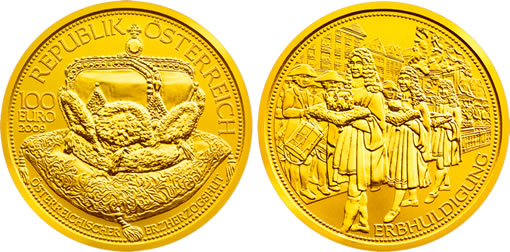The second 100 Euro coin in the gold series "Crowns of the House of Habsburg" will be released on Wednesday, 4th November. It is dedicated to the so-called "Archduke’s Hat", a name derived from the red velvet cap within the crown itself.
The title of archduke was invented by Rudolf IV in the spurious document of 1358/59 called the privilegium maius. It was an attempt to assert the status of the House of Habsburg as the equal of any Prince Elector of the Holy Roman Empire. There exists a mediaeval portrait of Rudolf wearing a crown similar to the Archduke’s Hat. Early versions of the crown have not survived, being either broken up or melted down.
In 1616, however, Archduke Maximilian III of Tyrol had the present Archduke’s Hat fashioned and he gave it to the Augustinian Abbey of Klosterneuburg just outside Vienna in honour of St. Leopold, whose tomb and shrine are still situated there to this day. The crown was not worn as such. There was no coronation. It was rather a symbol of authority and rank. It was brought into Vienna only for the ceremony of homage paid by the Estates of Lower Austria on the accession of a new Habsburg ruler. Even today the crown is not permitted to be outside the walls of the abbey for more than 30 days at a time.
The Archduke’s Hat is a diadem of eight golden peaks decorated with enamel, pearls and precious stones. Two pearl encrusted arches hold a sapphire mounted by a cross at their intersection. In the crown itself is a red velvet cap and the diadem is embedded in a circle of ermine, copying the hats worn by the Prince Electors. On the accession of a new ruler the crown was brought in procession into Vienna, conveyed in its own sedan chair. Along with other pieces of regalia such as orb and sceptre, it was presented to the new ruler and then carried in solemn procession from the palace to St. Stephen’s Cathedral for High Mass.
The new 100 Euro coin which was designed by Helmut Andexlinger, is struck exclusively in proof quality (reversed frosting) and in ducat gold (986 fine). The obverse depicts the crown itself resting on the cushion of state, upon which it was carried in procession in the palace and through the streets to the cathedral and back. The solemn procession is the theme of the reverse side of the coin. We see three high officials of the Lower Austrian Estates bearing the crown, orb and sceptre on cushions of state along the street known as the Graben (originally a defensive ditch outside the ancient Roman fortress). The periwigs and clothing of the officials point to the early 1700s. Soldiers line the processional route with a drummer beating a solemn rhythm. In the background rises the Baroque plague column erected in 1692, which can still be admired today on the Graben in Vienna.
The maximum mintage for this new issue is 30,000 pieces worldwide. Each coin comes in an attractive box accompanied by a numbered certificate of authenticity and a gold-plated lapel pin in the form of the archducal crown. A prestigious case for the whole collection of five coins may be acquired separately.
The series will continue in 2010 with the Hungarian Crown of St. Stephen, in 2011 with the Bohemian (Czech) Crown of St. Wenceslas and it will conclude in 2012 with the Imperial Crown of the Austrian Empire.
# # #
Crown of an Archduke commemorative gold coin specifications
| Alloy: | Gold, Au 986 |
| Finish: | Proof |
| Diameter: | 30 mm |
| Fine Weight: | 16 g |
| Mintage: | 30,000 |
| Date of Issue: | 4 November 2009 |
| Face Value: | 100 euro |
| Designer: | Thomas Pesendorfer |
The coin may be ordered through the Austrian Mint website. For the first issue in the series, see Austrian Mint Holy Roman Empire Gold Coin.
About the Austrian Mint
The Austrian Mint is situated in the heart of Vienna and is the official minting authority for Austria with a 800 year history.
The Mint is the source for all Austrian Euro and Cent coins, whether they are intended for shopping, as an investment or for collection. Before the Euro, the Schilling and Groschen coins were minted, and before that – during the monarchy – Crowns, Guilders and Ducats were struck by the Austrian Mint.
The company is located close to the centre at the Vienna Stadtpark in a Biedermeier building erected under Emperor Ferdinand I. from 1835 to 1837. Today it accommodates one of the most modern mints in the world.






